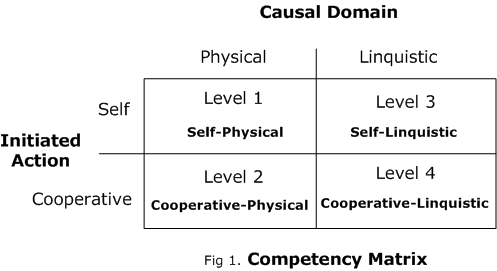
Scott Bristol's 'Values@Hand'.
Summary: LJMap's Values Coaching focuses on the client's use of specific 'value words' aimed at influencing 'cooperative competency'. Four different levels of competency are described. Particular attention is paid to Values Coaching which demands Level 3 and Level 4 competency. This presentation is divided into three major sections: 1) Values Coaching Theory which provides a theoretical framework for understanding values coaching; 2) Values Coaching in Action which applies the theory to a specific problem... buying a new car. Given this model, coaches can now review their personal values ranking scores and assess there coaching level.
Cooperative competency is the ability to achieve intentional results through the use of language. In organizational life two key questions that relate to an employee's 'cooperative competency' are:
Implicit in this approach is the recognition that all organizational tasks are interpersonal or cooperative in nature by the very fact they exist via languaging. Any task that involves language is interpersonal or cooperative in nature.
LJMap's values measurement, mapping, and coaching helps address both these questions.
Values coaching involves knowing how to make the client more aware of the specific value words he or she uses spontaneously to initiate and frame problem solving. The goal is also to heighten the client's awareness of the consequence of using his or her identified value words has on 'self competency' and on 'cooperative competency':
The implicit goal of coaching is to have the know-how to intentionally influence ones client. In order to achieve intentional results some form of causal logic and behavior is necessary on the part of the coach. An important awareness that coaches need to develop is understanding the difference between the causal domains of 'physical problems' and 'people problems'. Briefly, 'physical problems' have to do with influencing how 'physical objects' (computers, machinery, plants, animals, etc) interact, whereas 'people problems' have to do with how people influence each other, in particular through the use of words- languaging. In using the term 'causal domain' I'm referring to a system of thought and action (know-how) through which I achieve intentional results and competency.
What is being asserted is that the causal logic and science of 'in the world' enduring physical objects (physical domain) is not equivalent with the causal logic and science of 'languaging' (linguistic domain)- the cooperative act of influencing others to see and act the way we want.
'Day to day' problem solving involves the interaction of these two major causal domains. Where coaches often fail is in fully 1) understanding the science and logic of each of these two causal domains, 2) understanding how these two domains interact with each other, and 3) applying this to self's own values set that self is accessing and using via languaging to influence other's (client) value set in order to achieve 'cooperative competency' (Level 4 Competency).
Physical Domain adheres to the principles of 'event reproducibility'-"no theory can hope to predict a phenomenon that can't be reproduced" (Changeux and Connes,1995). Knowledge and science, our ability to intentionally influence our physical world, is grounded in 'event reproducibility' or 'event determinacy'.
Event reproducibility: If A then B, such that when ever 'A' occurs 'B' follows
Examples of event reproducibility: If I drop an stone it will fall, if I turn on the light switch the lights go on, if I turn my steering wheel left the car turns left. If these events don't happen they lead to a diagnostic aimed a finding error in the deterministic mechanisms. The pervasive logic of the physical domain is that the nature of the physical object determines how best to influence it, and it reactions are consistent. If you want water to be ice you have to lower the temperature below freezing. Efficacy and success are determined by understanding feedback from the physical object that is reproducible by its enduring physical nature.
The physical domain is the set of all physical objects that have durability in time and space.
Linguistic Domain adheres to the principles of 'event indeterminacy' - what follows a given event is not determinate. The linguistic domain is enacted and observed as languaging- intentional communicative acts of cooperation (Maturana & Varela, 1980). As such, words are behaviors that demonstrate and initiate cooperation and influence. But the causality of words is indeterminate. Consequently, probabilistic knowledge and science is used in domains of event indeterminacy.
Event indeterminacy:
Examples of event indeterminacy: Within the linguistic domain of humans, via languaging are:
Efficacy and success in the linguistic domain is dependent on two dynamics, first it is determined by the ability to approach and influence an event using the same or similar value words (that trigger similar degrees of meaning- behavioral expectation and competency), and second if the object of the event is physical in nature then the feedback from the object needs to afford data that can be linked with or coupled with the specific problem solving values.
The linguistic domain is the set of all spoken words. (I recognize this is a limited definition of linguistic. A more accurate and inclusive definition of languaging would include signing, mathematics, music, etc.)
A Domain of Competence is a specific area of expertise like teaching, farming, medicine, or engineering, that establishes its own set of specific languaging categories that agents use to trigger cooperation and achieve results. A domain of competence is circumscribed by a set of specific words that are used for languaging change . These words by their nature are not only descriptive but also can be action or change oriented. Efficacy within a given domain of competence is dependent on how practitioners integrate the feedback dynamics of the physical domain and linguistic domain into a cooperative and effective dynamic.
Different Feedback Schemas. The difference as presented in how feedback works in these two different domains builds on the observation that the physical domain lends itself to first order cybernetics and the linguistic domain lends itself to second order cybernetics (von Foerster, 2003) and self-referential systems theory.
Four different levels of competency are described by the Competency Matrix. This model will assist in describing different types of coaching and strengths and strategies for each. The two dimensions of the Competency Matrix are:

Level 1: Self-Physical competency focuses on how self manually works alone to intentionally influences his or her physical world. At this level languaging is not a necessary requisite.
For example, skills like carving, gardening, playing a musical instrument, and swimming are examples. Feedback direct from the physical domain defines efficacy and success, i.e. If I'm not swimming correctly I sink.
Level 2: Cooperative-Physical competency focuses on how self and other cooperate to influence their physical world. At this level, for humans, it's difficult to describe situations in which languaging is not present. Even so, the influence languaging has on competency is likely to be overlooked because of the nature of the feedback from the physical problem at hand.
Skills like carpentry, basketball, and ball room dancing are examples. Languaging is tacitly used with the implicit assumptions that others know what is meant when focusing on describing the physical world and efficacy and success is determined primarily by feedback direct from the physical world. If the roof isn't build right it leaks. If the play isn't executed we don't score. If my dance step is incorrect I step on my partners foot.
Level 3: Self-Linguist competency focuses on how self intentionally uses value words to 1) frame self's problem solving and 2) maintain self's motivation. Efficacy is self defined by what is personally meaningful and motivating- according to satisfying self's motivating values. Feedback from the physical domain is intentionally filtered through a self's personal values framework in determining success.
For example, assume my values and skills are that I'm most motivated to work co-creatively with my clients to come up with a training design and product that will custom fit my client's needs. And that in doing this I also know that I can bring my meaningful values and skills to bear on the the task and am confident that my performance will be motivating for me and the participants and successful at meeting the clients goals. But, if the client only wants 2hrs of training to address what from my values perspective (skills & motivation) is usually a three day workshop, then this assignment, should I take it, will not engage my motivating values (as described in the first two sentences). In fact, it may prove de-motivating because I will need to practice values I don't find rewarding in order to complete the task, even though what I produce may meet the client's expectations. Level 3 competency involves 1) knowing the values that motivate self and 2) making strategic choices to engage in problem solving according to an intentional set of values that may or may not motivate self.
Level 4: Cooperative-Linguistic competency focuses on how self intentionally uses value words to 1) frame problem solving, 2) increase cooperation between self and other, and 3) maintain motivation for self and other. Select value words that are motivating to self and other are intentionally used to frame problem solving. Efficacy is self defined by what is mutually meaningful to self and other. Feedback from the physical domain is filtered through an intentional mutual values framework in determining success.
For example, given my priority value and skill is 'helper', if my client say's "Help, I'm thirsty". If I give her a glass of milk, because that is what I like when I'm thirsty, and I don't 'inquire', 'consider', 'appreciate',... (see what she wants when she is thirsty is a glass of water, then I'm likely to fail at being 'helpful'- which is both a priority and meaningful value that I used to frame our client-helper relationship. It is only when I practice values like 'inquire', 'consider', 'appreciate'....(Empathy Path) in aiding to solve the problem at hand-quenching her thirst with water, that I move to Level 4 competency. In practicing these values I reinforce the efficacy and success of my 'helping' such that I'm motivated by my success and my client is motivated by getting what she truly wants- a glass of water and not milk.
These four levels of competency manifest and correspond to four levels of coaching:
Level 1 Coaches aren't often aware that they are in the act of coaching. Often as parents or leaders we aren't aware of when and how we are being watched and learned from as we go about doing our day-to-day work. This type of coaching is generally referred to as role-modeling.
Level 2 Coaches implicitly take the approach "I'm skilled at this task. If you do it like me you'll be successful." The assumption is that both coach and client see and experience the world in the same way- the coach and client have strongly aligned their respective natural worldviews. This approach assumes a high degree of tacit knowledge and works well in 'socialized' cultures that have a similar set of values that members identify with, are motivated by, and when used in problem solving generate efficacy and success (Nonaka & Takeuchi,1995).
Values Coaching: Level 3 and Level 4 demands two distinct shifts in awareness and skill.
When self engages at Level 3 his or her personal event space is expanded immensely by this shift. Now self's event space not only is occupied by physical objects but by 'self's value words'-intentionally used by self to influence such objects. There is also an awareness now that choosing different value words in problem solving has a different influence on self's skill and motivation. One is no longer an observer acting on and trying to influence a separate world, one is now a participant-observer.
* Mouse-over dark blue text gives definitions of values as measured by LJMap.
The Linguistic Shift and the Empathy Shift fundamentally changes ones approach to problem solving:
Four different levels of competency-the ability to achieve intentional results, will be defined and mapped with regard to a specific problem... 'buying a new car'. All four levels of competency as presented involve 'influencing'. Earlier the implicit goal of coaching was defined as having " the know-how to intentionally influence ones client", these examples although not about coaching per se, can be applied to a coaching relationship.
Four different levels of competency are described by the Competency Matrix. Dynamics and characteristics of each of these four levels will be applied to buying a new car. The two dimensions of the Competency Matrix are:

In order to demonstrate the graphic dynamics of values, in the four examples that follow, I'm only using a limited number of different values (4-8) to constitute a small problem solving orientation. A more accurate mapping of the dynamics would include using each person's Field of Meaning values, which on the average includes 34 different values, to build an intentional problem solving orientation , including at least 9 common values.
In order to better understand where and when each level of the 4 different levels competency appear it is necessary to understand how languaging and values influence different types of problem solving. The following graphic elements presented in the legend below will be used to map and explain four levels of competency applied to a specific problem... buying a new car.
Example event space Level 1: "I intend to buy a new car".

Listed below are four tacit values important to me that will influence my decision-making on whether to buy this specific car.
Tacit values are implied but not expressed. Self (affords) links tacit values to the object of attention without recognizing self's intentional choice or attribution. This dynamic results in self experiencing the object itself as manifesting the value when if fact the object is only coupling with self to elicit and confirm said value.
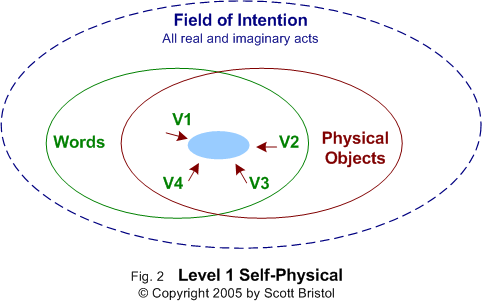
|
My tacit values in rank order#: |
* Mouse-over dark blue text gives definitions of values as measured by LJMap.
What physical characteristics do I couple or link with each value?
Problem Solving Dynamic (Decision Making): As an individual, after applying the 4 values listed and the physical characteristics that each value couples with, deciding to purchase has a high probability.
When trying to influence objects in my world I'm likely to act accordingly:
Event space Level 2: "My wife and I are intending to buy a new car".

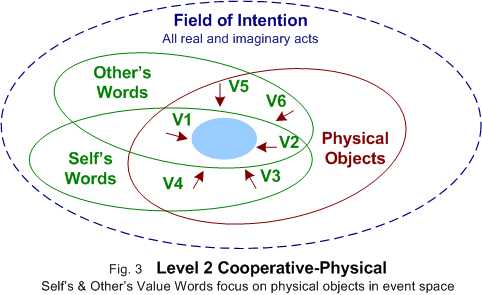
Event space Level 2: "My wife and I are intending to buy a new car".
| My tacit values in rank order#: | My Wife's tacit values in rank order#: |
What physical characteristics does my Wife couple or link with each value?
Problem Solving Dynamic (Decision Making): Using my top two ranked values, #1 V1 Quality and #2 V2 Economical to make this decision will have some influence on her, since she ranked these same values #3 and #4. But if I try to use my #3 and #4 ranked values, #3 V3-Engineering or #4 V4-Fun, to influence my wife to make this decision I'm not likely to be influential enough to get agreement. Since my values and the physical characteristics I can draw on to support my values (#3 and #4 ) are of no importance to her. The two values we share represent only 33% of the six values we are jointly, and tacitly, applying to this problem. Even though she is sharing the importance of her top two values, #1 V5-Safe and #2 V6-Practical , I don't attend to them because of my lack of interest in them. Likewise she too is not hearing or attending to my values V3-Engineering or V4-Fun. Consequently, only 2 of the total 6 values we are bringing to this event space are common, making it difficult to come to a decision based on a common set of values.
When trying to influence 'other' about problem we are both attending to in our physical world I'm likely to act accordingly:
In order to engage a Level 3 I need to make a Linguistic Shift, making myself more intentional in my awareness and application of my personal values that are most meaningful, motivating, and self-sustaining. In the diagram below you will see that 'self's value words' are now objects in self's event space along with physical objects. But other's value words have yet to enter self's event space.
Example event space Level 3: "I intend to buy a new car based on my motivating values".
In making this shift I first must be aware of the values that motivate me. I intentionally review my all my values from my Field of Meaning and see that 'conserving' is a more complex value that has significance for me that I want to apply to this decision. Consequently, I reformulate my the value list and come up with a new rank order I choose to apply to this decision.
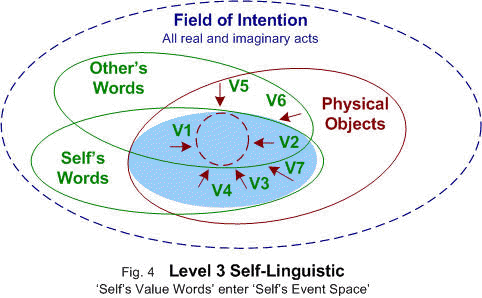
|
My intentional values in rank order #: | My Wife's tacit values in rank order#: |
This change in values results me focusing on a totally new possible choice. With an new set of physical characteristics that I can link or couple to my updated values list.

Problem Solving Dynamic (Decision Making): In becoming more aware and intentional in the application of my motivating values to this problem, I've ended up changing my approach and consequently possible solutions.
When trying to be intentional about attending to my priority values and realizing the motivational influence this has on me:
In order to engage a Level 4 I need to make an Empathic Shift, this involves intentionally engaging or adding a new priority values from the Empathy Path to my intentional values list. The Empathy Path consists of the following values: inquiring, considerate, appreciating, open-minded, empathizing, including, or interdependent, and selfless. In the level 4 map, this results in me 'opening' up my event space to 'include' all my wife's value words (V1,V2,V5,V6). Now not only am I attending to the 1) physical objects via my values, but I'm 2) attending to all the value words used by myself and my wife and 3) the influence this full set of values is having on how we are talking about the physical problem we are working on... buying a new car.
I select 'considerate' form the Empathy Path and add it to my intentional values set with a priority rank #1. With these values guiding and framing my problem solving I'm now able to 'consider (V8)' my wife's top two priority values, 'safe' (V5) and 'practical' (V6) that previously I was oblivious to. Also, reframing the task as a 'shared decision' also brings in the value 'interdependent'.
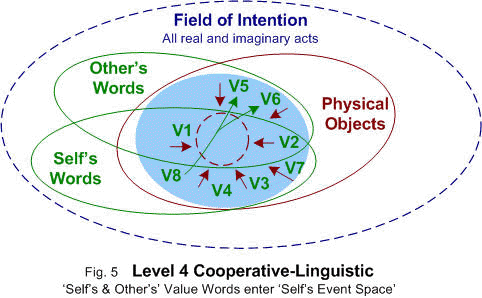
Event space Level 4: "I need to intentionally 'consider' my wife's values in order to make a 'shared decision'".
My intentional Values:
|
My Wife's tacit Values:
|
Problem Solving Dynamic (Decision Making) . Once I consider and include my wife's top two values, I see that neither car has physical characteristics that address the physical characteristics she personally is linking or coupling with 'safe' (V5) and 'practical' (V6).
Characteristics of Level 3 Competency (Cooperative-Linguistic)
Negotiating at this point might involve me 1) identifying additional physical characteristics that might have been over looked, and/or 2) adding modifications to the car, that would make it more safe and practical. The point being that without the empathic shift I'm not aware of the values that are important to other that I need to address. Without the empathic shift negotiations are not likely to address other's unmet needs, they are only likely to strengthen self's rationale for getting self's needs met.
Two-way Negotiating involves both party's adding an prioritizing a value from the Empathic Path to each respective intentional values set that each is using to guide their respective decision making. Both parties become aware and interested in addressing other's values that are and are not being addressed. This is usually a prerequisite for a win-win negotiation.
So if I also added considerate to my wife's priority values, she would become more aware of the importance I place on the values conserving, engineering, and fun. This might lead us to a practical reframing of the decision such that this car is not to be the family car, but my commute car. The family car which we will drive with our children will be selected based on the values that include both safety and conserving.
One-way Negotiating is when only the first party adds an empathic value and negotiates accordingly. This has the potential of being exploitive if the first party making the empathic shift expects the second party to make the same shift. Implicit in the empathic shift is a willingness of the first party to address the second party's unmet values. But, for the second parry, who does not make the shift their strategy is to strengthen the intentionality, importance, and rightness of their own values. So, when the first party makes the shift and is willing to address the second party's unmet needs, it supports the second party's basic strategy and they get what they want without needing to reciprocate.
Acting at Level 4 I'm likely to overlook:
So if you are a 'coach', at what level are you presently operating according to your measured values?
Values coaching starts with the coach understanding his or her own values ranking.
To answer these questions you need to have in hand your Field of Meaning Map. These are detailed LJMap printouts that display your personal values ranking scores for all 130 values.
Different Values Paths and there respective values are mapped as subset of Life Journey Map®.
| Values Paths | |||||||
Individual Development: |
Cycle of Self-Worth |
Cycle of Self Expression |
Cycle of Selfless Expression |
||||
Relationship Development: |
Foundation |
Utility |
Quality |
Service |
Cocreation |
Integration |
Navigation |
Steps: |
Col1 & 2 |
Col 3 |
Col 4 |
Col 5 |
Col 6 |
Col 7 |
Col 8 & 9 |
Leadership |
|
Achieving |
Managing |
Influencing |
Leading |
Architect |
Guardian |
|
|
|
Supporting |
Vitality |
||||
Empathy |
Reciprocating |
Inquiring |
Considerate |
Appreciating |
Including |
Interdependent |
Selfless |
|
|
Affection |
Empathizing |
|
||||
Openminded |
|
||||||
Helping Change |
|
Amending |
Teaching |
Counseling |
Wise |
Compassion |
Interpreter |
|
|
|
|
|
Servicing |
|
|
Presence |
Values coaching acknowledges the medium for influencing is languaging. The logic and science of the linguistic domain will frame LJMap's approach to values coaching. Consequently most of the strategy and dialogue about values coaching will be about the use of different value words and how they are applied to general problem solving situations.
In particular focus will put on the problem solving situation where the coach's client is a manager or leader. LJMap has identified different values paths that practicing coaches and leaders identify with.
A Values Path is a values theme defined by sequence of values (and corresponding skills) spanning 4 or more developmental columns. The developmental sequence asserts that in order to appreciate and skillfully practice higher order values it is necessary to master antecedent values and their corresponding skills.
Awareness of three different values paths begin to frame LJMap's problem solving situation: "How to coach leaders?"'
Helping Change Values Path is a set of values aimed at helping others change. Implicit in this developmental path are different approaches to personal change and personal goal achievement. This path is identified by the measured priority values from teacher, coaches, consultants, and therapist.
Helping Values Path: amending, teaching, counseling, servicing, wise, compassion, interpreter, presence
Leadership Values Path- values oriented towards using others to achieve organizational goals. This is the path identified by measured priority values from norm data of managers and leaders.
Leadership Values Path: achieving, supporting, managing, influencing, leading, architect, navigation
Empathy Values Path- is a set of values that suspend ones own self-interest in the interest of understanding and appreciating the 'values' of others who are different from self. When leaders or helpers engage these values, an Empathy Shift takes place, through with they are able to experience and influence the world according to other's natural worldview, not just their own natural worldview.
Empathy Path: affection, reciprocating, inquiring, considerate, appreciating, open-minded, empathizing, including, or interdependent, selfless.
Copyright 2005 by Scott Bristol